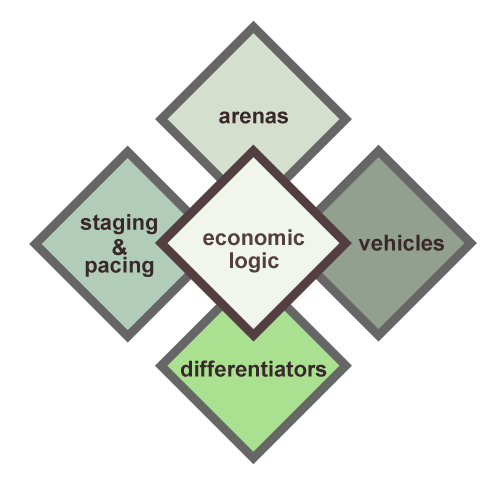All organizations have strategies. The real question for a business is not whether it has a strategy but rather whether its strategy is effective or ineffective, and whether the elements of the strategy are chosen by managers, luck, or by default. You have probably heard the saying, “luck is a matter of being in the right place at the right time”–well, the key to making sure you are in the right place at the right time is preparation, and in many ways, strategizing provides that type of preparation. Luck is not a bad thing. The challenge is to recognize luck when you see it, capitalize on luck, and put the organization repeatedly in luck’s path.
The strategy diamond model was developed by strategy researchers Don Hambrick and Jim Fredrickson as a framework for checking and communicating a strategy. The strategy diamond framework can be used systematically to examine a venture’s strategy logic and its strategy execution. The strategy diamond is more a checklist than a model. It suggests that good strategies include answers to a series of related questions spanning target markets, growth vehicles, speed and path of strategic change, and financial deliverables. The real power of a strategy diamond is that it integrates important choices into a bigger picture, instead of as a piecemeal approach.
The five key elements of strategy diamond model are: arenas, vehicles, differentiation, staging, and economic logic.
- Arenas indicate where the business will be active, and how much emphasis will be placed on each area. It encompass choices made about where to compete: the external environment such as product or service markets, geographic markets or channels. Arenas also identify value chain activities or value creation stages that are insourced or outsourced.
- Differentiators are those factors that are believed to allow the firm to “win” in its targeted arenas, particularly external arenas. Differentiators refer to attributes that enable a company to distinguish itself from its rivals and gain market share. It can include image, price, reliablity, and other key inputs. They require strategists to make up-front, conscious choices about which strategic assets will be assembled, refined, and deployed to beat competitors in the fight for customers, revenues, and profits. Creating differentiators is very important task top management should because without them a firm may lose its market position soon.
- Vehicles are the means to enter the arenas chosen. Deciding appropriate vehicles is of strategic importance. A firm can decide to develop organically, may decide to form a joint venture or may acquire the business of existing player in the targeted arena. A firm can use one or combination of these different vehicles to penetrate arenas. Vehicles are the means for attaining the needed presence in a particular product category, market segment, geographic area, or value creation stage. They are the result of deliberate strategic choice.
- Staging and pacing refer to the sequence and speed of strategic moves. This element helps identify decision points since strategic moves don’t have a single possible pathway. Staging process depends on many factors such as resources required carrying out the task, sometimes business need to respond quickly to grab opportunities available, in such situations urgency in taking actions is critical, achieving credibility is very important for attracting resources and stakeholders and lastly wining early in the strategy implementation phase is important.
- Economic logic refers to how the firm will generate profits above its cost of capital. A business strategy must clearly state how profits will be generated. Unless there is a compelling basis for generating business, customers and competitors won’t let that happen. The most successful business strategies have a central “economic logic” which serves as the fulcrum for profit creation. In some cases, the economic key may be to obtain premium prices by offering customers a difficult-to-match product. Economic logic for profit-oriented firms can take the form of scale economies, scope economies, premium pricing or some combination of these. For non-profit organisations, economic logic reflects how well the organization is achieving its mission and vision and serving its focal stakeholders.
Most strategic plans focus on one or two above elements of strategy diamond, often leaving large gaps in the overall strategy. When the five elements of strategy are aligned and mutually reinforcing, the firm is generally in a position to perform well. High performance levels, however, ultimately mean that a strategy is also being executed well. This leads to strategy implementation.
External Links:
- Are you sure you have a strategy? (Kean University)
